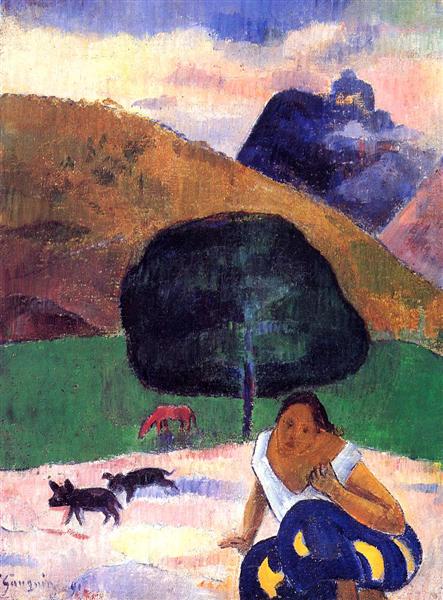Description
La peinture "paysage avec des porcs noirs et un tahitien accroupissant" de Paul Gauguin, réalisé en 1891, est un témoignage fascinant de l'approche innovante que l'artiste a adoptée envers le paysage et la figure humaine dans le contexte de la post-impressionnisme. Dès le premier look, l'œuvre est caractérisée par une palette de couleurs vibrantes et une utilisation audacieuse de la forme, des éléments qui sont devenus synonymes de l'esthétique gauguin et qui révèlent un lien profond avec la culture et le cadre du Tahití.
Au premier plan, nous observons l'image d'un homme tahitien qui est accroupi, un geste qui suggère une relation intime avec l'environnement. Sa position presque respectueuse invite les téléspectateurs à poser des questions sur le lien entre les hommes et la nature. La figure, ombrage dans des tons chauds qui fondent avec les éléments du paysage environnant, évoque une sensation d'harmonie et d'appartenance. Cet individu devient un symbole de la vie quotidienne et de la culture polynésienne, dans une période où Gauguin a été immergé dans son désir de trouver le "primitif" et l'authentique dans le monde. L'absence d'un visage clairement défini accentue l'universalité de son état, suggérant qu'elle représente non seulement un homme spécifique, mais aussi une multitude d'expériences culturelles.
Les porcs noirs, un élément remarquable de composition, se distinguent au fond du paysage, suggérant à la fois la vie agricole et une représentation du concept d'abondance. Sa couleur sombre contraste fortement avec les tons les plus brillants de l'environnement, provoquant une interaction visuelle qui fournit une dimension supplémentaire au travail. La présence de ces animaux peut également être interprétée comme un symbole de l'indigène, reflétant la relation entre la terre et ses habitants.
La composition se déroule dans une série d'avions qui donnent de la profondeur à l'espace, où les verts saturés des zones de végétation et le bleu du ciel sont entrelacés avec les tons terrestres de la terre et des porcs. Ce traitement des couleurs évoque un sentiment d'exubérance que Gauguin a cherché à capturer, un état de connexion presque mystique entre l'homme, la terre et la vie. De plus, son style distinctif de coups de pinceau lâche et d'applications de peinture épaisses renforce l'idée que le travail transcende le simple enregistrement visuel, devenant un acte plus émotionnel et spirituel.
Le contexte de ce travail est également significatif. Gauguin a déménagé à Tahiti dans l'espoir d'échapper aux restrictions de la société occidentale et de redécouvrir un sentiment de liberté. "Paysage avec des porcs noirs et un Tahitien accroupiré" est un produit de cette désir, reflétant à la fois sa fascination pour la vie tahitienne et son désir de réinventer la peinture dans un sens plus symbolique et subjectif.
L'œuvre s'inscrit ainsi à l'évolution de l'art moderne, avec une empreinte qui anticipe les tendances expressives ultérieures. Grâce à son approche unique de la couleur, de la forme et de la figure, Gauguin capture non seulement un moment évocateur dans le temps et l'espace, mais invite également les téléspectateurs à considérer la profondeur de l'expérience humaine par rapport au monde naturel. Cette œuvre et d'autres œuvres de sa vaste production rappellent que l'art imite non seulement la vie, mais sert également de moyen de réinterpréter et de réinventer l'existence elle-même.
KUADROS ©, une peinture célèbre sur votre mur.
Peintures à l'huile fabriquées à la main, avec la qualité des artistes professionnels et le sceau distinctif de KUADROS ©.
Service de reproduction des images avec garantie de satisfaction. Si vous n'êtes pas complètement satisfait de la réplique de votre peinture, nous remboursons votre argent à 100%.

